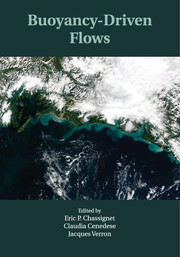Book contents
- Frontmatter
- Contents
- List of Contributors
- Introduction
- 1 Gravity currents – theory and laboratory experiments
- 2 Theory of oceanic buoyancy-driven flows
- 3 Buoyancy-forced circulation and downwelling in marginal seas
- 4 Buoyant coastal currents
- 5 Overflows and convectively driven flows
- 6 An ocean climate modeling perspective on buoyancy-driven flows
- 7 Buoyancy-driven currents in eddying ocean models
- 8 Atmospheric buoyancy-driven flows
- 9 Volcanic flows
- 10 Gravity flow on steep slope
- Index
- Plate section
- References
3 - Buoyancy-forced circulation and downwelling in marginal seas
Published online by Cambridge University Press: 05 April 2012
- Frontmatter
- Contents
- List of Contributors
- Introduction
- 1 Gravity currents – theory and laboratory experiments
- 2 Theory of oceanic buoyancy-driven flows
- 3 Buoyancy-forced circulation and downwelling in marginal seas
- 4 Buoyant coastal currents
- 5 Overflows and convectively driven flows
- 6 An ocean climate modeling perspective on buoyancy-driven flows
- 7 Buoyancy-driven currents in eddying ocean models
- 8 Atmospheric buoyancy-driven flows
- 9 Volcanic flows
- 10 Gravity flow on steep slope
- Index
- Plate section
- References
Summary
Introduction
Marginal seas subject to buoyancy loss, because of their semi-enclosed geometry, are source regions for the formation of dense intermediate and bottom waters. These convective water masses generally have distinct properties relative to the open ocean and can be traced far from their formation basins. They also can transport significant amounts of heat, salt, and other tracers throughout the world ocean. The vertical circulation and meridional heat and freshwater transports are fundamental components of the oceanic circulation, and play important roles in the global climate system. Understanding how this circulation depends on the environmental parameters of the system is important if one is to better model and predict the climate system and its sensitivity to changing atmospheric conditions, such as increasing anthropogenic carbon dioxide.
The focus of this review is on the circulation and exchange resulting from surface buoyancy forcing in marginal seas. General characterisitics of the exchange between the marginal sea and the open ocean are described from eddy-resolving numerical models in idealized configurations, and the physics governing this exchange are elucidated through a combination of numerical models and simplified analytic models. Although the problems are couched in terms of marginal sea–open ocean exchange, many of the processes that emerge from this analysis are relevant to more general buoyancy-forced flows. Particular attention is paid to the dynamics involved with net vertical motions forced by surface cooling.
- Type
- Chapter
- Information
- Buoyancy-Driven Flows , pp. 118 - 163Publisher: Cambridge University PressPrint publication year: 2012



